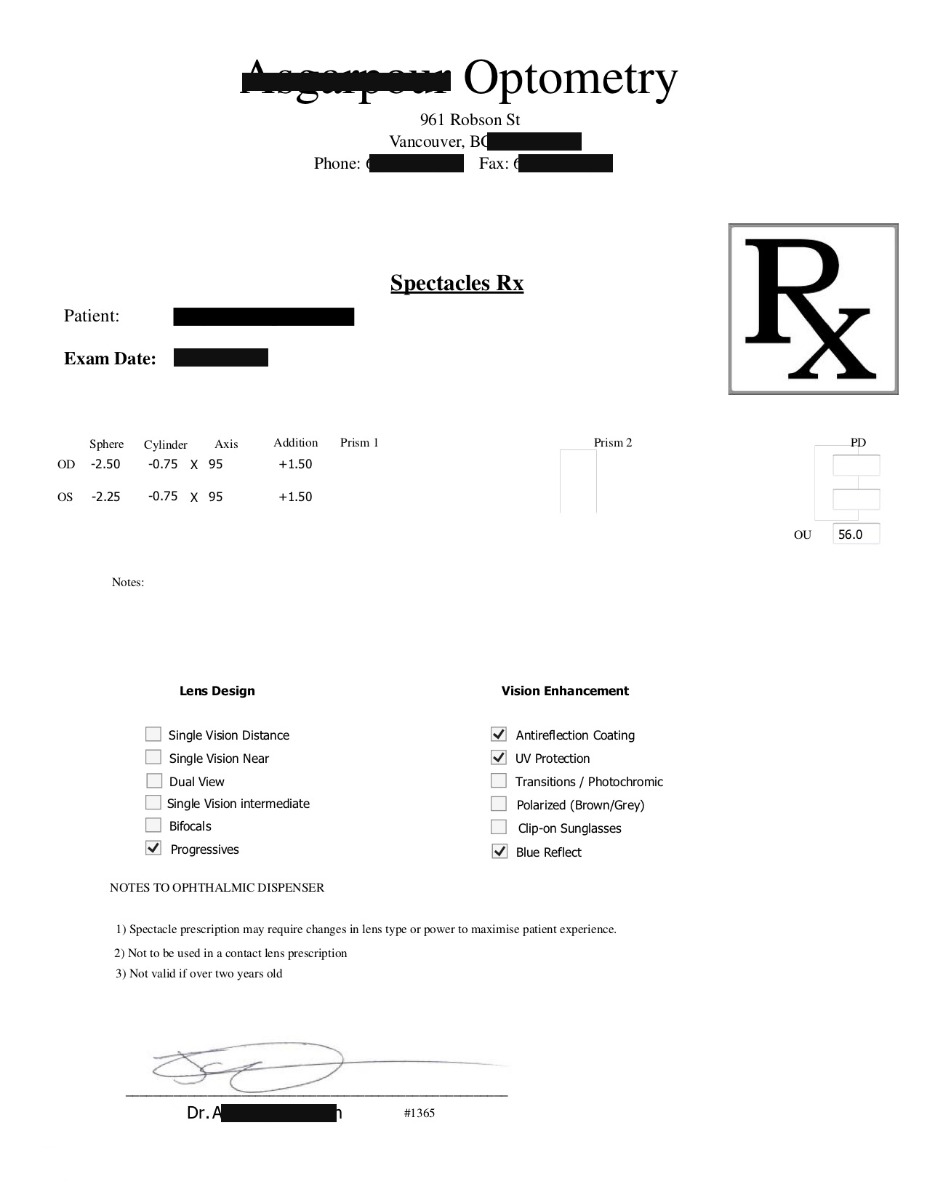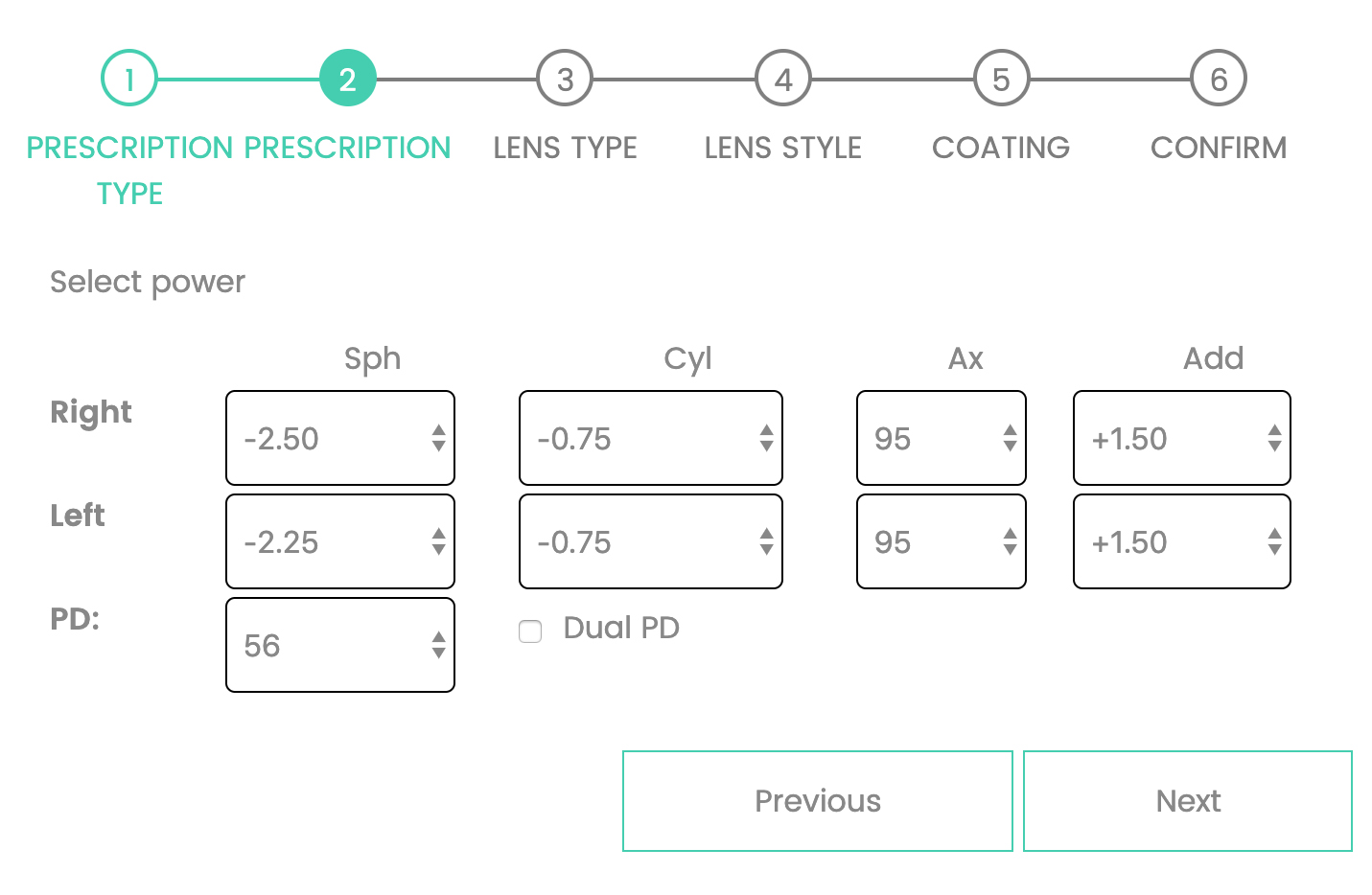Understanding Your Prescription
Looking for a new pair of glasses but you’re not sure how to read your glasses prescription? We’re here to help!
After an eye exam, you’ll receive an eyeglass or contact lens prescription with specific information about your eyesight and correction needs. With your prescription in hand, you are ready to buy your next pair online! Before you complete your order, you should first know how to read your glasses prescription and contact lens prescription.
What Do the Numbers on My Prescription Mean?
Your prescription may include the following: SPH, CYL, Axis, ADD and Pupillary Distance (PD). The first four parameters have to do with your visual correction. The PD is a crucial measurement we need to make your glasses. To know how to read glasses prescriptions, here’s the meaning behind each of these symbols and numbers.

§ OD “oculus dexter” indicates your right eye’s parameters.
§ OS “oculus sinister” shows your left eye’s parameters.
§ SPH “sphere” indicates the amount of lens power prescribed for nearsighted or farsighted vision. It is measured in diopter and uses (+) for farsightedness (hyperopia) and (-) for nearsightedness (myopia).
§ CYL & AXIS: a Cylinder (CYL) and Axis number (between 0 and 180 degrees) are required to correct Astigmatism. Both parameters will be required together.
§ ADD: provides magnifying power for reading, bifocal, multifocal and progressive lenses. You will most likely have the same number for both eyes that usually ranges between +0.75 and +3.00.Occasionally, lower add powers than +0.75 can be found on a prescription. These are for Anti-Fatigue Lenses such as the SightRelax (link).
There is a separate prescription for your right eye and your left eye. Most of the time, OD and OS are indicated on the left of your prescription and the following numbers show each eye’s specific needs. Some glasses prescriptions also include additional numbers such as:
§ Prism: measured in prismatic diopter (p.d.). It is required when eye alignment needs assistance. It is indicated as follows: BO (base out), BU (base up), BI (base in) or BD (Base-down). Each one of these indicators provide information about the base direction or the thickest edge of the prism. Clearly does not offer prism prescription glasses.
How Do I Read My Glasses Prescription?
In addition to the general parameters, eyeglass prescriptions can require a Pupillary Distance (PD). Your PD is the distance between the centre of one pupil (the central black dot of your eye) to the centre of the other pupil. It is measured in millimetres and is an important part of your prescription.
PD indicates where the optical centre of your lenses should be placed so you can have the best, most comfortable vision. It is generally mentioned in your eyeglasses’ prescription with the letter PD, if you can’t see it, you can learn how to measure your pupillary distance.
This is how you would include the numbers on our website for glasses:

Special Features on My Prescription
You could also find additional information on your glasses prescription such as the suggestion of certain types of lens coating and special comments from your optometrist.
§ Lens designs on a prescription indicate your eyesight requirement, detailing the lens’ design and function (single, progressive, bifocals…).
§ Vision enhancement: a special treatment for one or both lenses used to improve vision and clarity through your glasses. You could find different options such as:
§ Anti-reflective coating (Green Coating): enhances clarity and concentration by allowing more light to come in and reduces reflection.
§ UV protection: to prevent your eyes from being damaged by the sun’s UVs, your lenses can come with special anti-UV treatment.
§ Photochromic: these lenses are equipped with a technology that adjusts your glasses’ tint according to the light. When the sun comes up, your glasses turn into sunglasses!
§ Blue light blocking glasses (Blue Coating): a special coating that protects your eyes from artificial light by reflecting blue lights that come from digital devices.
What Is the Difference Between Progressive, Bifocal and Single Vision Glasses?
The differences between each type of glasses are not always clear. To understand how to correctly read a prescriptions for glasses, here is an overview of the main categories of lenses that can be written on your prescription.
§ Single vision lenses: a large majority of glasses come with single vision correction. This common type of lens is generally used to correct nearsightedness, farsightedness or used as reading glasses.
§ Bifocal lenses: these glasses come with two vision corrections. One is on the lower part of the lens to help you read or see from near, and the other on the upper part includes a distance prescription.
§ Progressive lenses: multifocal lenses offer multiple corrections in one pair. These prescriptions have a no-line lens and offer intermediate distance vision, which can be adapted for certain specific uses, such as computer work.
How do I Read My Contact Lens Prescriptions?
Your glasses and contact lens prescriptions are actually different. If you want to purchase contact lenses, you’ll need a specific prescription from your eye care professional. In addition to the general parameters that we’ve mentioned, a contact lens prescription will include a Base Curve and a Diameter.
BASE CURVE (BC) & DIAMETER (DIA)
If you’re not sure whether you have an eyeglass or contact lens prescription, verify whether your prescription includes:
§ Base Curve (BC): the number that indicates your contact lens’ shape. According to the steepness or flatness of your cornea, your prescription indicates how large your contact lens should be.
§ Diameter (DIA): a number indicating your contacts’ length to make sure they’ll cover your cornea properly.
§ Brand: your eye doctor will determine the appropriate brand and type of contact lenses for you, according to your preferences and specific requirements.
§ Expiration date: your eye care professional will determine an expiry date for your prescription. Past that date, you’ll require a new prescription for contact lenses. These are generally set annually.
§ Corrective power: these are the numbers associated with the actual power needed in your lenses. These numbers often change (or disappear) between your glasses prescription and your contact lens prescription, especially with higher powers.
If you find the information displayed above on your prescription, there’s no doubt that you have a contact lens prescription! Both the Base Curve (BC) and Diameter (DIA) of a contact lens ensures a proper fit on your cornea and total eye surface. Those features ensure comfort and encourage eye health, including allowing proper oxygen to the eye.
